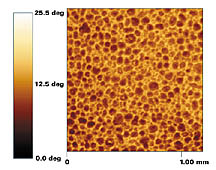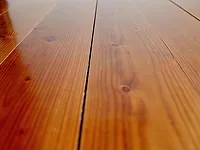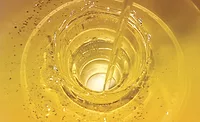Waterborne Parquet Coatings Based on Crosslinked Polyurethane Dispersions

Characteristics of Polyurethane Coatings
All polyurethane coating systems are produced by the isocyanate-polyaddition process in which isocyanates and suitable co-reactants are combined to produce polymers containing urethane groups (see Figure 1).The characteristic feature of polyurethanes is their chain structure of hard and soft segments. The hard segments have a large number of urethane groups that crosslink physically through the formation of hydrogen bridges. While the hard segments can form crystalline structures, the soft segments are comparatively mobile. From the combination of these attributes in the same molecule, the tough but flexible property profile of polyurethane coatings is achieved.
Despite the advantages of waterborne polyurethane coatings based on polyurethane dispersions (PUDs) for parquet floor coating application, there are some shortcomings about current commercially available systems.
- Low black heel mar resistance
- Inadequate storage stability of the dispersions and the formulated coating
- Poor chemical resistance under severe exposure
- Inadequate grain accentuation of the wood substrate

Fatty Acid Modified Polyurethane Dispersions - Oxidative Crosslinking
Despite their physical crosslinking by way of hydrogen bridges, coatings using PUDs are, to a certain extent, thermoplastic. As a result, the heel marks left behind by hard shoe soles can often lead to irreversible damage. These heel marks virtually burn into the film.It seemed logical to solve this problem by introducing an additional chemical crosslinking process. The first option is to introduce the oxidative crosslinking mechanism by way of drying oils - a method that has already proved itself in the parquet segment. Many attempts have already been made in this direction to improve the overall properties of waterborne coatings. In most cases, however, the result turned out to be an inadequate compromise. The improved black heel mar resistance (BHMR) was achieved at the expense of the abrasion resistance or the yellowing resistance.
The introduction of drying oils into the polymer structure of an aqueous polyurethane dispersion can be carried out in a variety of ways. To maintain the desired properties of the waterborne PUD coating, it is important to introduce a minimal amount of drying oil. To achieve a crosslinking effect that extends beyond the particle interfaces, even with low oil content, the crosslinking unit must be very mobile. This means that the fatty acid should be incorporated in the soft segment of the polyurethane. In the case of high-molecular-weight PUD coatings, very low oil content (less than 10%) is enough to obtain the desired properties. However, the introduction of crosslinking components into the soft segment leads to a reduction of the elasticity and thus decreased abrasion resistance. This can be compensated through careful selection and arrangement of the high-grade components such as cycloaliphatic diisocyanates and soft segments with excellent mechanical properties.
A careful choice of the raw materials also makes it possible to formulate a PUD coating with excellent storage stability. After four weeks at 50 degC or even after three freeze/thaw cycles between -10 degC and +20 degC, the properties are virtually the same as they were at the beginning. This also applies to other critical parameters such as antifoam stability and viscosity.
The resulting high-molecular-weight PUD, with less than 5% co-solvent, guarantees rapid drying while low mean particle size leads to high wet film transparency and also accentuates the grain.
This new development permits the formulation of one-component aqueous coatings with excellent black heel mark resistance, good chemical resistance, improved appearance and grain accentuation. At the same time, yellowing and abrasion resistances are similar to that of the traditional aliphatic waterborne systems.

Waterborne Two-Component Polyurethane Coatings
Aqueous two-component polyurethane systems are a young class of binders for parquet coatings. In this market, a two-component coating will only be accepted if its overall properties are significantly better than those of a one-component system. Other key factors for the acceptance of a two-component system are ease of mixing, ease of application and acceptable potlife.Good results are obtained when a high-molecular-weight polyurethane dispersion is used as Component A. Even without a crosslinking agent, the PUD produces a high quality finish. The properties of Component A contribute certain overall coating properties such as hardness and drying rate. The incorporation of Component B, the polyisocyanate crosslinking agent, produces a level of chemical and mechanical resistance previously unattained in waterborne coatings.
For manual application, it is essential that the curing agent can be easily incorporated into Component A. People have been using hydrophilically modified polyisocyanates as the crosslinking agents for this purpose.
When designing a crosslinker for waterborne coatings, the level of hydrophilicity must be adjusted to achieve target properties because:
- A high (but not excessive) content of hydrophilic groups simplifies incorporation of the crosslinker,
- An excessive content of hydrophilic groups, on the other hand, impairs the chemical resistance.
A new generation of hydrophilically modified polyisocyanates was therefore developed.
In comparison with the traditional types in which the hydrophilic group is linked by way of urethane bonds to the basic polyisocyanate matrix, the new generation contains allophanates that are formed from a urethane further reacting with isocyanate. At the same level of hydrophilic modification, an allophanated polyisocyanate disperses far more finely in water than the traditional urethane.
This simple modification to the crosslinker structure significantly affects the properties of the two-component system. Our new crosslinker for waterborne parquet coatings can be easily dispersed simply by shaking the container. Resultant particle sizes are in the range of ~100 nm, which are also the typical values for polyurethane dispersions. Therefore, for the first time, thorough mixing under parquet coaters?ractical conditions is now possible.
An analysis of such coatings by 13C-NMR spectroscopy has shown that the polyisocyanate reacts (for the most part) with moisture to form the polyurea network. The crosslinking principle is thus similar to that of conventional, moisture-curing polyurethane. The film morphology of an aqueous two-component polyurethane coating of this kind can be illustrated with the aid of atomic force microscopy (AFM) in the tapping mode. In the cured aqueous two-component polyurethane coating, a matrix of polyisocyanate surrounds the polyurethane particles, of which there is a large surplus. This matrix is very soft, but highly crosslinked. Even in the cured film, the polyurethane particles from Component A can still be individually recognized under AFM. These particles are significantly harder than the polyisocyanate matrix. In other words, an additional 'overstructure' is created in the film as well as the described hard/soft morphology of the polyurethane molecules. Due to the small particle size of the initially water dispersed polyisocyanate there are no large domains of polyisocyanate in the film. In the case of previously used polyisocyanates, these large domains tend to result in turbid films after drying.
A combination of our new polyisocyanate with a high-gloss Component A produces a highly resistant, high-gloss waterborne two-component polyurethane coating (see Table). Upon incorporation of the crosslinker, the coating system has a potlife of about five hours and still yields consistent properties. After this time, the most significant change is gloss reduction.

Radiation-Curing Polyurethane Dispersions
While polyurethane dispersions dominate the market in the field of environmentally friendly parquet coatings for manual application, they are not commonly used in ready-made parquet floors.Ready-made parquet is roller coated primarily with unsaturated acrylates. The elimination of the drying section for solvent removal and the fast curing speed of the radiation-curing process save a considerable amount of time. Urethane acrylates in particular can also satisfy the stringent requirement of abrasion resistance.
However, the disadvantages of this technology include the following.
- The high degree of crosslinking is the main reason for the high shrinkage of such coating systems. This shrinkage often leads to adhesion problems between radiation-cured coatings and the wood substrate.
- The flexibility, even of high-grade urethane acrylates, does not attain the level of aqueous PUDs.
- It is more difficult to down-gloss these high-solids systems than it is with waterborne coatings.
- The reactive thinners currently used are often a concern for an occupational hygiene point of view.
- The roller application of 100% systems often produces a rather inferior finish.
These UV-curable aqueous dispersions have a molecular weight that is many times higher than that of traditional systems consisting of an unsaturated acrylate and a reactive thinner. This is why the waterborne systems need much less radical crosslinking to obtain the desired properties. This means:
- The toughness and flexibility of polyurethanes are largely retained, which leads, for example, to high abrasion resistance and elongation.
- The shrinkage is much lower; aqueous radiation-curing polyurethane dispersions are therefore ideal as adhesive primers in a parquet coating system for industrial application.
- The photoinitiator requirement is lower - an important cost factor.
The advantages of these systems over 100%-solid UV-curing coatings are that it is much easier to obtain a matte finish and that they can be applied by curtain coating. Thus the aqueous, radiation-curing systems are also ideal for the topcoat for ready-made parquet flooring.
Their inherent disadvantage compared with the 100%-unsaturated acrylates is the presence of water. Water has to be removed from the film before UV curing. As aqueous coatings become more popular, highly effective drying equipment has been developed that can be used for such applications.
The optimum coating system for ready-made parquet flooring would be as follows.
Summary
Because of their outstanding overall property profile, aqueous polyurethane dispersions are the most popular class of binders for environmentally friendly parquet finishes. Proven technical advantages over conventional parquet coatings are their high abrasion resistance, rapid drying and their minimal detrimental impact on the environment.A low level of oxidative crosslinking is enough to significantly reduce the thermoplasticity of one-component waterborne coatings. This leads to greatly improved black heel mark resistance. With the development of fatty acid modified PUD, it is also possible to achieve excellent abrasion and yellowing resistances, good storage stability and improved grain accentuation.
It is known from conventional one- and two-component polyurethane coatings that crosslinking via polyisocyanates brings a significant additional improvement in the resistance properties. With our new generation of water-dispersible polyisocyanates with more effective chemical linkage of the hydrophilic groups, it has become possible for the first time to formulate easy-to-apply waterborne two-component polyurethane coatings with a high surface gloss.
The newly developed UV-curable PUDs marries the advantages of radiation curing technology and aqueous PUD technology to achieve the desired properties including various gloss levels with high throughput and excellent adhesion to the wood substrate.
We are convinced that polyurethane dispersions will continue to gain popularity in the field of industrial parquet coatings. The enormous range of structural parameters makes it possible to develop a tailor-made solution for just about any coating system.
This article is based on a paper presented at the International Waterborne, High-Solids and Powder Coatings Symposium February 21-23, 2001, in New Orleans. The symposium is sponsored by The University of Southern Mississippi Department of Polymer Science.
For more information on polyurethane dispersions, contact Christoph Irle, Bayer Hispania S.A., Pau Claris, 196, 08037 Barcelona, Spain; or Bob Wade, Bayer Corp., Coatings and Colorants Division, 100 Bayer Road, Pittsburgh, PA 15205-9741; phone 412/777.2871; fax 412/777.2084; visit www.bayerus.com; e-mail bob.wade.b@bayer.com; or Circle Number 90.
Links
Looking for a reprint of this article?
From high-res PDFs to custom plaques, order your copy today!







